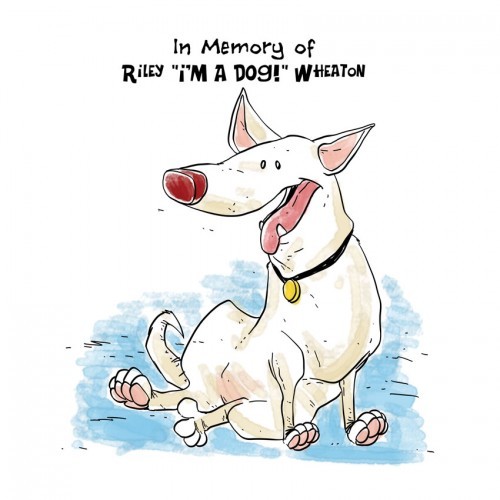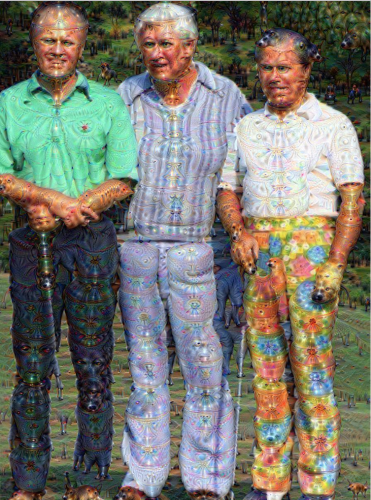Wil Wheaton's Blog, page 56
September 26, 2015
a family photo, of sorts
When I bought my first house, I wasn’t entirely sure how to decorate it. I’d lived in apartments for years, and didn’t have much experience beyond posters from movies and bands, and I certainly didn’t put photographs into frames, because that was what adults did.
When I bought my first house, I was not ready to be an adult (that’s a whole other story), but I did my best to decorate it the way I thought adults did.
So, in the second of my two bedroom house (the bedroom I didn’t sleep in), I put up my version of a family photograph, in an actual frame, on the night stand.

For those of you born after 1980, or who have been painfully deprived of classic(?) American television, that is the cast of The Love Boat.
Also, I wasn’t particularly good at dusting, apparently. (Again: not good at adulting.)
This was so amusing to me, I bought pictures of the cast of Diff’rent Strokes, Three’s Company, and CHiPs. I put those pictures in frames, and even hung some of them on the walls.
Come to think of it, maybe I was doing a decent job of adulting, because being an adult means that we get to decide what that means.


September 23, 2015
This is why I support a SAG-AFTRA strike authorization for video games — and it isn’t about money.
I’m getting yelled at by people on Twitter because I support my union (SAG-AFTRA)’s efforts to negotiate a better contract for voice performers like myself who perform in video games.
The most frequent complaint goes something like this: “actors work for maybe a few days at most on a game, and they want residual payments?! Programmers and others who work on those same games spend literally years of their lives on them, and they don’t get residuals! Actors are greedy jerks!”
I can’t speak to the fairness or unfairness of residuals or lack of residuals for programmers, artists, composers, and others who game developers and publishers, because that’s not my job, and I don’t know what, precisely, their contracts are. I certainly don’t believe that there is some sort of feud or lack of shared interest between us (the actors) and them, and I fully support all the people who work on games — especially the huge blockbuster games that pull in profits that are in line with the biggest blockbuster movies — getting the very best contract, with the best compensation and best working conditions that they possibly can.
But I did not give my union authorization to call a strike on my behalf because of this issue. I voted to authorize a strike because our employers in the games industry refuse to negotiate with us at all about some very, very important issues surrounding our working conditions.
Let me share some excerpts from an email I got from SAG-AFTRA recently (emphasis mine):
You may have heard that billion-dollar companies like Activision, Warner Bros., Disney and Rockstar Games are against sharing any of their record-setting profits with the performers who help make their games awesome. But…
DID YOU KNOW…
Our employers have rejected every proposal that we’ve put on the table? That includes the community’s proposals to reduce vocally stressful sessions to two hours, […]
This, right here, is reason enough to strike, as far as I am concerned. I fully realize that for anyone who doesn’t work as a voice actor it sounds insane to care about vocally stressful sessions. I realize that when you hear that actors want to reduce those sessions to two hours or less, it can easily create an impression that actors are lazy and entitled, and don’t want to work as hard as other people do.
Listen, if you truly feel that way, I hope you’ll do something to give you some perspective on what this actually means. I really want to help everyone understand what we do when we use our voices to bring video game characters to life, and why the expectations (I believe they are demands) from our employers are unreasonable.
Okay? Let’s get started. Since you probably don’t have a video game script at hand, we’re going to simulate it. I want you to grab your favorite book, and I want you to read, out loud, twenty pages from it. Really put your heart and soul into the dialog, and bring it to life. I need to feel emotion, and I need to be invested in the characters. Now, go do it again, but just slightly different this time, because we’re going to need options. Okay, you’re doing great. You’ve been at it for about two hours now (if you average around six minutes a page, like I do), so take a ten minute break. Drink some hot tea with lemon and honey in it, and then go read it one last time.
So you’re about three hours into it — that’s it! Just three hours! Five hours less than an average (union-negotiated) workday! Your sinuses are feeling a little raw, because you’ve pushed a lot of sound and moisture out of your body. You probably feel some emotional fatigue, because you’ve been putting a lot of emotion into your work. But you’re a professional, so you don’t complain. In fact, you’re grateful for the job, because if you’re lucky you’ll get to do this maybe twice a month. And, honestly, this is still better than coal mining, right? Right.
Okay. Still with me? Good. You can eat lunch now, if you want. You probably go for something with a lot of salt in it, because it soothes your vocal chords. I’m a big fan of the chicken soup, though sometimes I’ll have a burrito, because #burritowatch.
Lunch is over. You’ve been at work for about 4 and a half or five hours at this point. You’re going to go read another ten pages from your book, but I’m only going to ask you to do it once, because you’re probably in the zone by now and you are nailing most things on the first take.
It’s time for the call outs, and then you’re done for the day. Maybe you’re done for the whole job! Awesome. Here’s what you’re going to do: you’re going to make a spreadsheet, with 40 rows on it. In each row, you’re going to put a line of dialog that you’re going to do three times in a row before you move on to the next line. This spreadsheet will have a few columns, with the dialog in the first column, and some direction in the second column. There’s a third column, usually, but that’s got information in it that’s not relevant to our job as actors, so ignore it.
I’ve made you a sample of a few lines from a military game I made up, to help you get started:
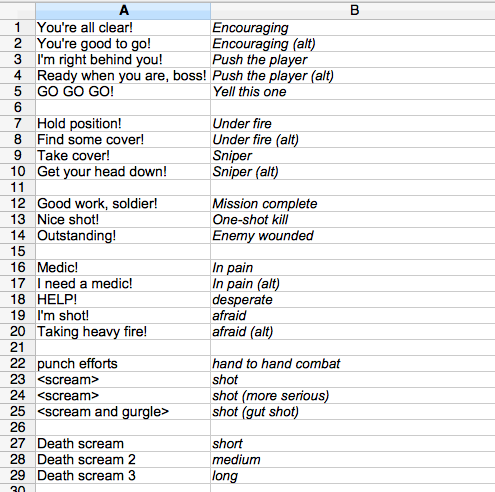
You’re going to do each of those three times, sometimes four times. You’re also going to do this for three more hours. Don’t worry, you can take a couple of short breaks — and you’ll need them — to drink some more of that tea you’re getting sick of.
If you’ve done this as I asked, it’s now six or seven hours after you started. Don’t talk at all for the rest of the day, and don’t make any plans to go audition for any other voice work for the rest of the week, because your voice is wrecked. Don’t go to any kind of day job that requires you to talk with anyone, either, because you’re not going to be able to do that. Oh, and over years and years of this, it’s going to build up into serious and permanent damage … and then you’re not going to be able to work with your voice anymore.
The fact that our employers won’t even talk with us about this growing problem, that affects the ability of all voice performers to take care of themselves, is reason enough to go on strike until they will.
But there’s more. Our employers also refuse:
[…] to hire stunt safety coordinators to protect actors’ well-being in the PCap volume, to share with us and/or our representatives the actual name of the games we work on, and to outline the nature of the work we’ll be doing?
Working in Motion Capture is amazing, and that technology has allowed some of the most incredible works of videogame art in history to be created. The Last of Us, Grand Theft Auto V, Heavy Rain, Uncharted 4, are just a few of the titles that have been brought to life by talented performers using their voices and their movements to create a realism that was unheard of fifteen years ago. It can be dangerous work, especially when there are fights involved, so when we work in live action film or television, there is always a trained, qualified, professional stunt coordinator on set to ensure that nothing goes wrong and nobody gets hurt. The performers who work in those scenes should be afforded the same protection we get when we’re on a traditional film or television set.
And I totally get the desire for studios to protect their upcoming releases by using codenames for various projects when we audition, but asking — in this case expecting — us to go into something with absolutely zero knowledge about the project, or what we’ll be expected to do if we are cast, is completely unreasonable. Maybe someone has a moral objection to the content of a game, and they’d like to know what it is before they commit to it. Maybe they get to see three pages of the script (usually just single lines with no context) and they wouldn’t take the job if they found out the part was just one scene, followed by sixty pages of call outs, being delivered by several different characters. Or maybe they just aren’t into the project when they find out what it is. The point is, expecting actors — or anyone — to commit to a job without knowing exactly what it entails just defies common sense. We have got to be able to figure out a compromise that fairly and equitably addresses everyone’s concerns. You know, a negotiation.
But it gets worse, because these people, who have refused to address a single proposal from SAG-AFTRA, have some ideas of their own that they apparently expect us to just accept without question:
Our employers want to be able to fine you $2,500 if you show up late or are not “attentive to the services for which [you] have been engaged.” This means you could be fined for almost anything: checking an incoming text, posting to your Twitter feed, even zoning out for a second. If a producer feels you are being “inattentive,” they want the option to fine you $2,500.
Our employers want to be able to fine the union $50,000-$100,000 if your franchised agent doesn’t send you out on certain auditions (like Atmospheric Voices or One Hour One Voice sessions)?
I’m sorry. What? The studios want to fine SAG-AFTRA up to $100,000 if our agents don’t send us out on an audition? Because these same people who refuse to discuss any of our proposals for this upcoming contract believe … what, exactly? That they own us all and they can force our agents to do whatever they want them to do? This makes literally no sense at all.
If your agent chooses not to submit you for certain auditions, our employers want to put into our contract language forcing SAG-AFTRA to revoke your agent’s union franchise. This would mean that your agency would not be able to send you out on any union jobs, including those in animation, TV/film, commercials, etc.
So this is ludicrous. I can not think of a single instance in the history of the entertainment industry where a studio of any sort has asked for and gotten something like this. If my agent doesn’t submit me for something, for whatever reason, that’s between my agent and me. Maybe I don’t want to work for a certain studio, so my agent doesn’t submit me for their projects. Maybe I don’t want to work with a certain director, or another performer or whatever I feel like because I’m a sentient human being who makes his own decisions. These employers (at video game companies and video game studios) want to have the option of preventing our agents from submitting us for any work at all, and that’s outrageous. Our relationship with our agents is, frankly, none of any studio’s business.
IT’S NOT JUST SECONDARY PAYMENTS WE’RE FIGHTING FOR. IT’S THE FUTURE OF THE WORK WE DO.
We are at a crossroads, and we have a choice to make.
This is the crux of it, really. It really, really, really and honestly and truly isn’t about money. Sure, payment and compensation is certainly part of it, but it’s not all of it, and it isn’t even the biggest part of it. We really are fighting for the future of our ability to work in this business.
If we stand united, we have a chance to make real gains in this contract and to avoid these onerous rules and fines. SAG-AFTRA is one union now. We have power we’ve never had before, and it needs to be deployed now.
If we don’t stand together, we won’t even be able to maintain the status quo.
That’s why your Negotiating Committee, Executive Committee and National Board have all voted unanimously to support this action. Now, it’s in your hands. We hope you’ll join us and vote YES for a strike authorization.
Voting YES for a strike authorization does NOT mean we are on strike, it does NOT mean that we have to strike or that we will strike. It simply means that you authorize your Negotiating Committee and elected representatives to call for a strike against video game companies as a last resort, in order to make sure that your safety and well-being are protected, and that your future is free from any unnecessary fines and penalties. A strike authorization gives your Negotiating Committee real power at the bargaining table.
I love the work that I do. I’m grateful for the work that I have, and I’ve been lucky to work with some incredibly talented people on both sides of the recording studio glass. This isn’t about making enemies of the other creative people in the business, be they directors, studio engineers, artists, programmers, sound designers, writers, etc. This is about a handful of extremely wealthy, extremely powerful people trying to take away our ability to make a living, to take care of our voices, and to be safe on the set.
We in the voice acting community — along with the programmers and engineers, of course — have helped video games grow into a multi-billion dollar industry. Video games rival movies not because we push buttons and get loot, but because video games tell amazing stories that touch our lives in ways that movies can not.
I sincerely hope that a strike won’t be necessary. I sincerely hope that our employers will come to the negotiating table and talk with us in good faith, to reach an agreement that’s fair.
But if they won’t, I’ll go on strike unless and until they will, because I believe that #PerformanceMatters.


it pays my way and it corrodes my soul

I’m home from a vacation that I desperately needed, and in twenty minutes, I’m going straight to work on something that I love.
It feels weird to not post stuff here regularly (like, daily, I mean), but it also feels good to take some time to myself and reassess what I want to do with my time, how I feel about what I’ve been doing with my time, and also, like, what is time … really, man?
I don’t think I’m going to be writing in my blog as much as I’d like to for the near future, because putting pressure on myself to write here makes me not want to write here. That probably means I’ll go on some kind of blogsplosion soon.
But! If you just can’t get enough of me, you probably want to follow my Tumblr, because I post stuff there several times a day, even when I’m letting tumbleweeds and dust pile up on my blog. I’ve also been making Radio Free Burrito pretty regularly, and of course there’s my stupid Twitter thing.
Okay bye.


September 10, 2015
A Guide To Being A Dog, by Seamus Wheaton, is now an actual book that you can own.
Poking my head up from my break to share this, because I think it’s awesome…
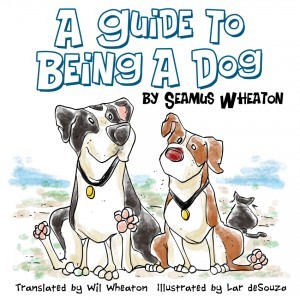 Some of you know that Anne and I have a non-profit foundation that raises money for organizations like NAMI, Planned Parenthood, and others. This month, as we do every September, we’re doing a fundraiser for the Pasadena Humane Society.
Some of you know that Anne and I have a non-profit foundation that raises money for organizations like NAMI, Planned Parenthood, and others. This month, as we do every September, we’re doing a fundraiser for the Pasadena Humane Society.
For a few years, I’ve written these silly tweets that are excerpts from a book that doesn’t exist, called A Guide To Being A Dog, by Seamus Wheaton. It’s all the funny things that Seamus would tell a puppy who is learning how to be a dog, like
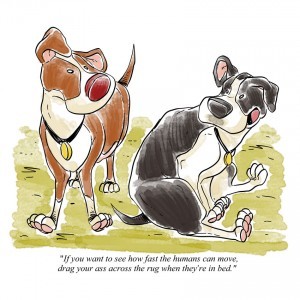 “If I stand very still and stare at it, maybe you’ll give me some of your bacon.”
“If I stand very still and stare at it, maybe you’ll give me some of your bacon.”These tweets always get lots of RTs and favorites, and people have been asking me to put them into an actual book for years … so we did!
Anne and I hired our friend, Lar deSouza, to illustrate about 90 50* of my favorite tweets, and we put them into a nifty little 8×8 book that is on sale through our foundation right now.
It’s pay what you want (minimum $40), with all of the profits going directly to the Pasadena Humane Society, via our Wiggle Waggle Walk team.
Here’s Anne, with a little more about this year’s project:
For the past two years, we have done a rescue pet calendar project in support of our participation in the Wiggle Waggle Walk; an annual event put on by the Pasadena Humane Society at the end of September. It was a really fun project to create, and between those two calendars, we raised about $76,000 for PHS, which was awesome.
This year, we decided to do something new, and I am so excited to finally share it! Over the last year, Wil has written dozens of ridiculously adorable tweets as if our dog, Seamus, is giving advice on how to be a dog, ending each post with “A Guide To Being A Dog – by Seamus Wheaton.” I thought it was such a cute idea (as did many others) so I decided to make them into a book. I wanted the illustrations to show that Seamus is giving our dog, Marlowe, this advice, seeing as how she’s the younger one and newer to our household, and it turned out cuter than I EVER imagined.
I asked our friend and amazing artist, Lar deSouza, to do the illustrations, and he happily obliged. He captured the personalities of Seamus and Marlowe perfectly, as well as the personalities in the cameos of our cats, Watson and Luna. As cute as this book is, I would not categorize it as a children’s book, unless you’re okay with your children reading about “taking a shit on the patio” or “dragging your ass across the rug.” But that’s your parenting call. The majority of the book is not like that, but I thought it best to warn you.
You can purchase a copy in our store, for a minimum $40 donation. Your donation goes to our 501(c)3 foundation, and your tax-deductible donation will help us support rescue animals in need. We anticipate that demand will be very high, so to ensure everyone who wants a book can get one, and that shipping and handling is manageable for us, there is one book per donation, please.
You will not be put on any mailing lists, and the information you provide us will never be shared.
Oh, and this book (and this year’s walk) are dedicated to a very special pooch:
Lots of readers have been asking for this, and I’m super excited that it’s now A Thing That You Can Have. I’m also hopeful that we’ll get close to or even break our existing Wiggle Waggle Walk records, with your help.
Please note that, due to demand and other practical considerations, we are not able to offer signed copies at this time. Books will ship near the end of September.
Okay, I’m going back to my break, now.
*math is hard


September 9, 2015
ctrl + ] send brk
I’m taking a little bit of a break from everything, so here’s Marlowe to put a little awwwwww in your day.


September 5, 2015
stuff i like that you may like
From the most recent Radio Free Burrito’s show notes:
This show’s theme music is Blank Space, by Taylor Swift.
The videos for Style and Wildest Dreams are so good.
Tove Lo’s Queen of the Clouds is the first pop concept album I think I’ve ever heard.
I did not expect to love the Mocking Jay Part One soundtrack, and yet.
TV Crimes is a new podcast I do with Mikey Neumann.
The Battle for Zendikar is going to be a really fun set to play.
Your long wait to have 13 minutes of commercials from Little Rock radio in 1971 has come to an end.
The Memory Palace is amazing.
You Must Remember This is your new favorite podcast.
There is not a single crystalline entity in Lore.
Easy Riders, Raging Bulls is an incredible book. I also just found out that it was made into a movie and now I have to see it IMMEDIATELY.
You can watch The Trip on YouTube.
You can see some wonderfully weird Kenneth Anger films there, too.
John Waters is my hero.
Leadbelly’s Where Did You Sleep Last Night? is really great.


August 31, 2015
tears in rain
I walked out of the loading dock, through a cloud of rotting garbage, and into the alleyway behind the theater. A curtain of rain fell between me and my destination, a little over a block away.
“Do you want to wait here, while I get you an umbrella?” Liz, the producer from Wizards of the Coast, asked me.
“No,” I said, stepping into the rain, extending my arms outward and turning my palms and face to the sky, “it’s been so long since I felt rain fall on my body, I’m not going to let this opportunity pass me by.”
I walked down the sidewalk, surrounded by other PAX attendees. Some were not bothered by the rain, while others held up programs and newspapers and other things to keep it away. A man walked his dog next to me. The dog was unperturbed by the weather. We got to the corner and waited for the light to change. The rain intensified and it was glorious.
“Are you sure this is okay?” She said.
“Oh yes, this is so much more than okay,” I answered, “this is perfect.”
Earlier
Les Baxter’s soothing sounds were not soothing at 6am. Quiet Village played on my phone, which was, by comparison, better to wake up to as an alarm than an actual alarm’s jarring screech. Still, at 6am, the only thing I want to hear is whatever is in my dreams.
I dragged myself out of bed, silenced my alarm, and started my day.
Coffee.
Muffin.
Shower.
Hairstyle.
Retry hairstyle.
Beard oil.
Retry hairstyle.
Brush teeth.
Give up and accept hairstyle.
Elevator.
Lobby.
“Good morning,” April, from Wizards of the Coast, said.
“LIES!” I said with a smile.
“Can I get you a coffee?”
“Yes. You can get me all the coffee.”
“How would you like your coffee?” A new guy asked me, joining us. “I’m Brad from Wizards,” he told me.
“Angry. I want a big cup of angry coffee.”
We all laughed as Ashly Burch joined us.
“Good morning, Ashly,” April said.
“More lies,” I said, “there is no such thing as a good morning at bullshit o’clock.”
We went on like this for a few more minutes, my anti-morning sass offset by Ashly’s relentless happiness and positivity. Coffees in hand, we walked out of our hotel and a few blocks away to the theater where we were hosting the Battle for Zendikar preview show for Wizards of the Coast, thirteen hours in the future.
Rehearsal went as well as a rehearsal can at 7am (bullshit o’clock plus one hour, if you’re scoring on the Wheaton Clock), and a second run through was legitimately good. The point of the thing was to introduce a bunch of new cards that are about to come out in the Battle for Zendikar set, and to do it in a way that was hopefully amusing to the people on the room, and the Magic fans watching on the Internet. In a little over thirteen hours, we’d know if we succeeded.
I thanked everyone for a good couple of run throughs, went back to my hotel, and took a nap. I woke up, ate a sandwich, and took another nap. Then I woke up for real, went downstairs, and headed back into PAX to play Magic against as many people as I could in two hours.
If the presentation was the work, this was going to be the fun. I haven’t played Magic competitively in well over ten years, and I’ve only played casually in the last five or six years. Until I started preparing for this weekend, I didn’t know what was happening in the story of Magic, and there were a lot of current mechanics that I wasn’t familiar with. But I did a ton of homework, and with the help of some friends (especially my friend, Graham Stark, who really held my hand through the whole process), I entered the battlefield, as ready as I could be against players who dueled on a regular basis.
In the story of Magic, the world of Zendikar is currently being attacked by a species of terrifying creatures called the Eldrazi. These creatures are massive and ancient and hungry. They are so hungry, they devour everything in whatever plane they happen to invade. From their point of view, this isn’t a bad thing (they just want to scoop up everything available at the buffet), but from the point of view of literally every other living thing in the multiverse, the Eldrazi need to be stopped and contained. So these powerful Planeswalkers used the magic inherent to Zendikar along with these things called Hedrons to trap the Eldrazi there. Everything was great for a few thousand years, but now things are not so great. The Eldrazi are awake, hungry, and anxious to get back to feeding, starting with Zendikar itself.
That’s where I and a bunch of really cool and interesting people come in. We all played the role of the Eldrazi, in duels against players who were the representing the Zendikari. I had one deck that was built around summoning these massive Eldrazi creatures, and the players had their choice of three different decks that used different strategies, according to their skill level.
The players were, literally, battling for Zendikar. When a certain number of player victories were achieved, the image of an Eldrazi creature on a huge screen would be replaced with the image of a preview card from the next set, Battle for Zendikar. It was a clever and fun way for Magic fans to both duel against some cool and interesting people (or me), while they also worked as a group to get a first look at what’s coming up next in the game they love to play.
It was incredibly fun. I’m not good at Magic by any objective measure, and I’m certainly not going to offer any kind of meaningful challenge to a player who is experienced in tournament play … but I am pretty good at playing a role, and in these duels I was playing the role of the bad guys, which is something I’m fairly comfortable — some may even say good at — doing.
I learned how my deck was constructed with the help of Rich Hagon, a Pro Tour announcer. “You want to stay alive long enough to get enough mana to cast these big creatures,” he told me. “It won’t be easy, but when you can hit them, you’ll hit them hard.”
“Back when I played regularly, I liked to play with small, fast, ‘death by a thousand cuts’ decks, so this is the opposite of my preferred playing style,” I told him. “I think it’s going to be fun to get out of my comfort zone and do something different.”
Rich wished me luck, we discussed the possibility of him joining me for Tabletop next season, and I got ready to go to work. Well, I mean, to play. Even though I was technically working, I was actually actually playing in the way people play for enjoyment. Playing was also my job for the next few hours, so I guess I was going to work to play. Which was for work. But mostly for play.
Still with me? Good.
I got wrecked in my first game, which gave me tons of mana but not a lot of creatures. I won my second game, using a bunch of smaller creatures to absorb damage from the other player while I got more and more lands into play, finally casting a couple of Eldrazi who were very big and very nasty, including Ulamog the Infinite Gyre.
Win or lose, though, a couple of things happened in every duel:
I had a really good time, and so did the other player.
None of the people I played with traded the joy of playing for the pursuit of winning.
Every player told me how excited they were to play with me, and that they’d been hoping I’d be the Eldrazi (from the more than twenty possible players) they’d face.
This last thing was really awesome, because I could feel how happy it made these people to play with me. I’ve been feeling pretty much the opposite of awesome for several weeks, now, and actually getting to sit down, face to face, in a semi-quiet few moments with real people who wanted to be there with me was … restorative, I guess is the best word. One player told me, “Thank you for everything you do. From Tabletop to Titansgrave — which is the best thing I’ve ever seen — to talking so openly about anxiety and depression.” He then destroyed me, with the final life counts being -8 for me, and 43 for him. It was awesome.
Part of my Depression is this voice that never stops telling me that I suck. Part of my Depression is this constant fear that everyone will know how afraid of failure I am. Part of my Depression is this relentless worrying, in the face of mountains of evidence to the contrary, that I’m never going to do anything that matters.
I know that all of those thoughts — occasionally sincerely held beliefs, even — aren’t rational. I know that they are intrusive and part of depression lying, but when the depression and anxiety are very strong and very loud and I’m feeling very sad about some things, the guard who sits between my rational mind and my irrational emotions is easy to sneak past, and when Depression sees that happen, it makes the most of the opportunity.
I was really worried that I was going to suck when I did the presentation with Ashly on Saturday night. I was really worried that Magic players — who aren’t exactly renowned for being the most welcoming and inclusive people on the planet — wouldn’t give me a chance, because I don’t play as frequently or intensely as they do. I was worried that I would be tired and that I would make stupid mistakes that made me look unprepared. Depression saw all of that, and it pounced. I was, basically, a big ball of anxiety up until the moment the presentation was finished, and for a fair amount of time after, too.
I did make some stupid mistakes, but I thought I pulled out of them in an entertaining way (the folks who hired me told me they liked what I did, and the writers of the script were pleased with what I did, so I’ll let them judge). Ashly was perfect, and she made us both look better than I deserved. But I really did have fun talking with Mark Rosewater, who is the head designer for Magic, when we revealed to the world the preview cards we showed during the duels, and some others (like full frame dual lands) that made Magic fans go bananas.
(If you can spell bananas without Gwen Stefani doing it for you in your head, you’re missing out on something great.)
So putting it all together, it was a good and successful event. Yeah, the people who hate something that I do because I did it are always there, and yeah the type of Magic player who needs to be a gatekeeper didn’t like it, and there were some people who just didn’t like it because it wasn’t what they were looking for. All of that is totally fine, of course, but they were outnumbered by at least 20:1, and maybe even more.
But all of that isn’t even the best part of the day, or even the trip, for me.
The best part of the day came at the end of my last duel. The guy I was playing with was kicking my ass. I was down to, I think, 5 or 7 life, and he was still close to 20. I got super lucky and was able to play a card that wipes everything off the table that isn’t colorless, which cleared off all his creatures and gave me a couple of rounds to get out Ulamog, who went to work destroying all of his lands and creatures, and then devouring him. With the win, I finished 4 and 3 on the afternoon.
I extended my hand and thanked him for playing, because it was a genuinely fun and challenging match. He took my hand and he said, “I was really hoping that I’d get to play with you, because you saved my life.” Before I could respond, he continued, “everything you’ve written and shared about anxiety and depression helped me get treatment for my own mental health.”
It’s not the first time someone has said something like this to me, but this guy and I had spent about twenty minutes playing a game together, and we’d sort of bonded a little bit, the way people do when they’re playing a game. I felt an unexpected swell of emotion, and I said, “I’m really happy to know that I could help you the way Jenny Lawson helped me. I have to tell you that I haven’t been feeling very awesome lately, and the last few weeks have really been a struggle. In fact, I’ve had to take [medication] every day this week just to get through the day.”
He laughed. “Me too!”
“The thing I think we have to remember is that there is no finish line with depression, anxiety, or any other sort of mental illness. We’re on this path, and the path is constantly changing. Sometimes it’s flat and well-marked, and we can see all the way to the horizon.” I realized that I had gone from shaking his hand to holding it. “Other times, it’s so heavily shrouded in fog and mist, we can’t even see past our fingertips and we need someone to show us where the path is. And sometimes, we come to a wall that we don’t think we’ll ever get over. I’ve been staring at the base of that wall for weeks, and just now you helped me remember that there are always handholds to get up and over it.”
“You were one of my handholds,” he said, with a squeeze of my hand.
And that’s when we both began to cry.
“I’m sorry,” I said, wiping tears off my cheeks, “it’s been a really shitty few weeks, and you just really, really made me feel better about myself.”
We began to laugh through the tears, and when we composed ourselves, we took a picture together.
“Thanks for playing with me,” I said, “and thanks for … everything else, too.”
“You’re welcome,” he said.
“Play more games!” I said.
“I will!”
The announcer told the crowd that we were about to reveal another new card, and there was much rejoicing.
Later
I had a little less than an hour between finishing the games and starting the presentation.
Again, I walked back to the hotel to change my clothes. I reflected on my final duel, and another, similar conversation I had with a different player right after it that is so deeply personal I’m not going to recount it.
It was raining, again. I looked up into it, again, and let the rain fall on my face.


August 24, 2015
a little more deep dreaming
I’ve been playing with Google’s Deep Dream a little bit. I like the way these two images turned out:
This rose came from an original photograph I saw on Reddit. I like how it looks like a rose with maybe some pepper or something in it when you look at a small thumbnail, but when you embiggen it to its full size, there’s a whole lot of creepy stuff going on in there.
The other one just finished dreaming a few minutes ago. It’s based off of this picture of three politicians in regrettable golf pants.
Here’s the image as the dream is getting started. Again, you’ll want to embiggen this to fully appreciate it.
It would have been fine to stop it there, because it’s just a little creepy, but I let it go deeper into the dream…
We’ve moved from creepy into funny and a little surreal, but by the time it was done, it had gone all the way back around to creepy and landed in nightmare.
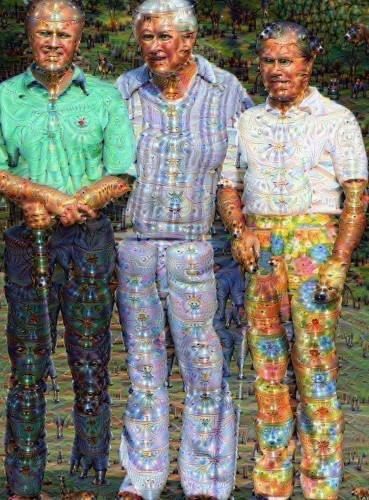 I particularly like how Tip O’Neill is getting literally two-faced in that final image.
I particularly like how Tip O’Neill is getting literally two-faced in that final image.


August 23, 2015
Another August 23rd
August 23rd is the official birthday of Wil Wheaton dot Net, which went live on this day way back in 2001, in all its ugly hand-coded glory.
I didn’t know then that this blog would change my life, begin a new career for me as a writer, and eventually give me a second act in my life. It’s been one hell of a journey, and this is one day that I stop for a moment to both enjoy and celebrate the success I’ve had, while recommitting to take nothing for granted, and keep doing my best to earn good people in my life.
This year, I don’t much feel like taking a victory lap, because I feel like there’s still so much to accomplish and so much that I want to do, and after all this time I am more fearful than ever that I’m going to wake up and find that it’s all gone.
August 23rd would also be River Phoenix’s birthday, and while I don’t think of him often, when I do, I can’t help but wonder how he’d be doing right now, and if we’d even be in each other’s lives. It’s so weird to know that I’m 43 with two adult children, and he never even got to be 25.
I don’t know what else to say. I’m a complicated mix of emotions and thoughts today, and I can’t find the right words to express them.


August 21, 2015
Tabletop Submission Criteria
While I was at GenCon meeting with game publishers, I learned that a longtime friend who I completely trusted to be a liaison between me (and Tabletop) and game publishers was abusing and betraying that trust in the worst way. Among several profoundly upsetting revelations, I learned that our submission criteria was not being clearly communicated to designers and publishers. This isn’t fair to anyone who has a game they think would work on the show, and is personally upsetting to me, because I probably missed more than a few potentially awesome games.
I have taken significant steps to ensure that the problems we experienced in season three as a result of that betrayal will never happen again. As we get ready to select games for next season, I want to ensure that everyone knows how we choose games to play, so nobody’s time, money, or resources are wasted.
So what follows is a copy of the email we are sending to all the publishers we met. It is also published on geekandsundry.com, where anyone can view it. It’s also here, because I want to make sure that everyone who needs or wants to see this can see it.
To the Publishers:
At GenCon this year, after meeting with dozens of game publishers, it became clear to us that our submissions process for TableTop was broken. The first step toward repairing this process is better direct communication between us at TableTop and the publishers we hope to work with. Rather than rely on a single person to communicate our submission criteria, we are publishing it online and in email, so everyone has access to the same information.
The following criteria will help you determine which of your games are most likely to be played on TableTop:
Your game must be available at retail outlets when its episode of TableTop airs. We will not consider games that are in development, in stages of crowd funding, or otherwise not available for gamers to purchase and play.
We have 4 players on each episode of TableTop, so your game should work best with 4 players. This does not mean that it can be played by only 4 players, but it should really shine with 4 players. A good example is Bang!, which technically works with 4 players, but is at its best with 7 or more. As much as we love Bang!, it just won’t work on Tabletop.
Games can not require simultaneous play, or need to be played in real time. Games like Escape: The Curse of the Temple or Jungle Speed are super fun, but the simultaneous play makes them impossible to film and edit.
Your game should have a strong, good balance of strategy and luck. We want everyone who plays to feel invested throughout the episode. Skewing too far in one direction or the other may leave some players out.
Your game should look good and be produced on quality materials. TableTop is a visual show, after all, and we need the games we feature to look awesome.
Games need to be playable in about 90 minutes to fit into our production schedule, and to allow us edit the final cut to about 35 minutes. Longer games are occasionally okay for two part episodes, but those are rare exceptions.
For season 4, we’re very interested in seeing and playing games that are accessible to families. We’ve seen that a huge portion of the TableTop audience is made up of families who watch together, and we want to play some games this coming season that they’ll love to play together. This does not mean that we’re looking for children’s games. Rather, we are looking for games that can be played by a wide range of ages. For example, Catan Jr. is a game you can play with your kids that is not a kid’s game. Smash Up is probably a little complex for a 7 year-old, but a 10 year-old shouldn’t have any trouble with it. Both of those games can be fun for adults to play with or without their kids.
We want you to know that games fitting all these criteria are the most likely to end up on the show. We anticipate over 200 submissions this season, from which 18-20 will be selected for TableTop, so a game that fits all 6 of these criteria will probably edge out one that fits only 4. However, if your game doesn’t fit all of these rules, but fits most of them, we’d still love to see it. If your game breaks one of these rules in a spectacular and interesting way, we’d also love to see it. Please let us know in your submission if this is the case, which criteria you did not align with, and why you think we’ll love it. Please note, Rule 1 is non-negotiable.
Rather than send product, we’d like to save you time and money. Please submit information about your game to Ryan Copple & Claudia Sanchez at tabletopsubmissions [at] geekandsundry dot com. We’ll need to know the title and designer of your game, the core mechanics, playing time, target age, and when it will be available in stores. You may include marketing materials if you think they will be helpful for us.
We will compile a list from these e-mail submissions and reach out to those of you who have games we believe could be a good match for our show. At that time, we’ll ask you to send those games to the Geek & Sundry offices, directed to Ryan & Claudia’s attention. We are asking for a minimum of 2 copies of your game. One copy will go to Wil Wheaton, to play with his family and his game group. One copy will be played by the offices of Geek & Sundry. Going forward we do not require more than 2 copies of a game in order to consider that game for Tabletop. If you are able to send a 3rd copy it may help us ensure as many people as possible can play the games, but 2 will be enough for consideration.



